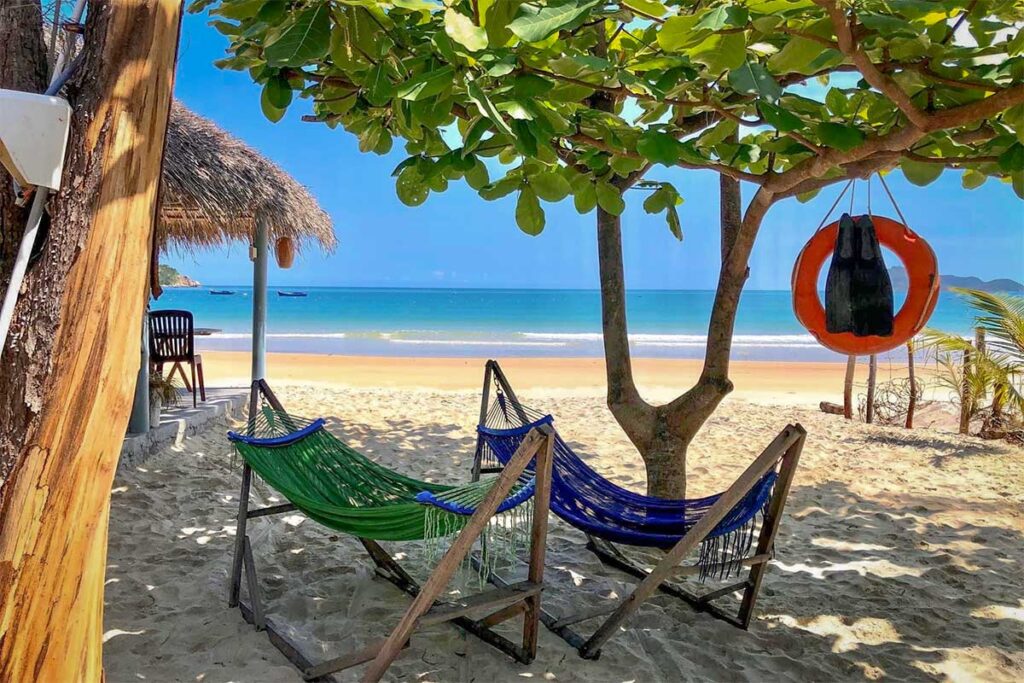What are Tu Nham Beach with Vinh Hoa Beach like?
Tu Nham Beach lies on a peninsula in the Song Cau area of Phu Yen Province, about halfway between Quy Nhon and Tuy Hoa. The bay stretches for several kilometers, and its northern end is known as Vinh Hoa Beach, home to a small fishing village and the few guesthouses available. When people talk about staying at Tu Nham, they usually mean this Vinh Hoa section, since that’s where all accommodation and most visitor activity is found.
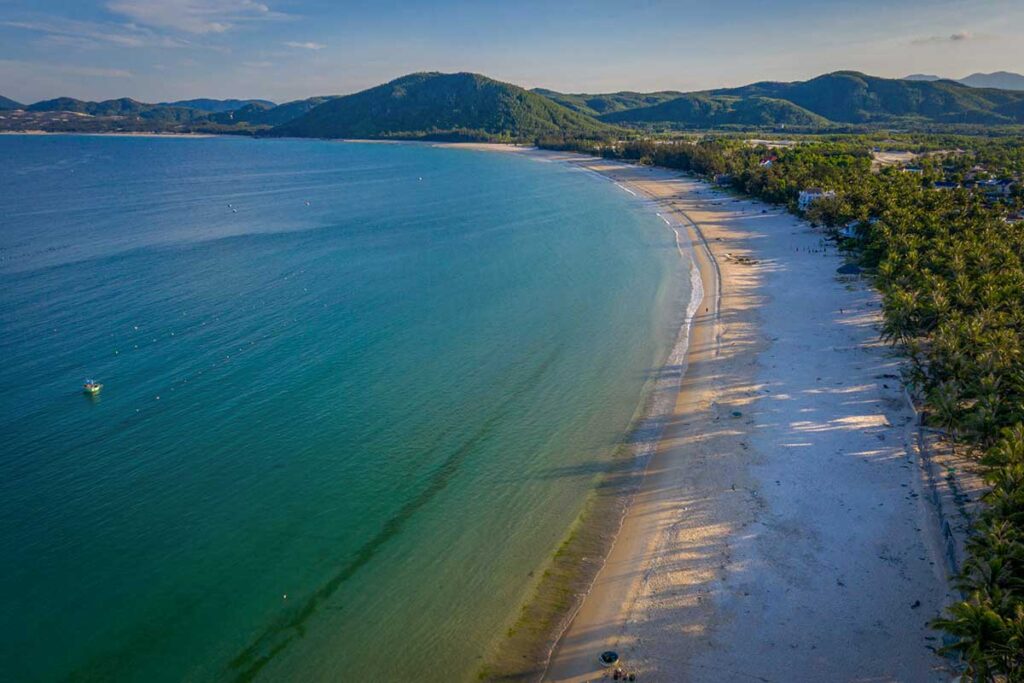
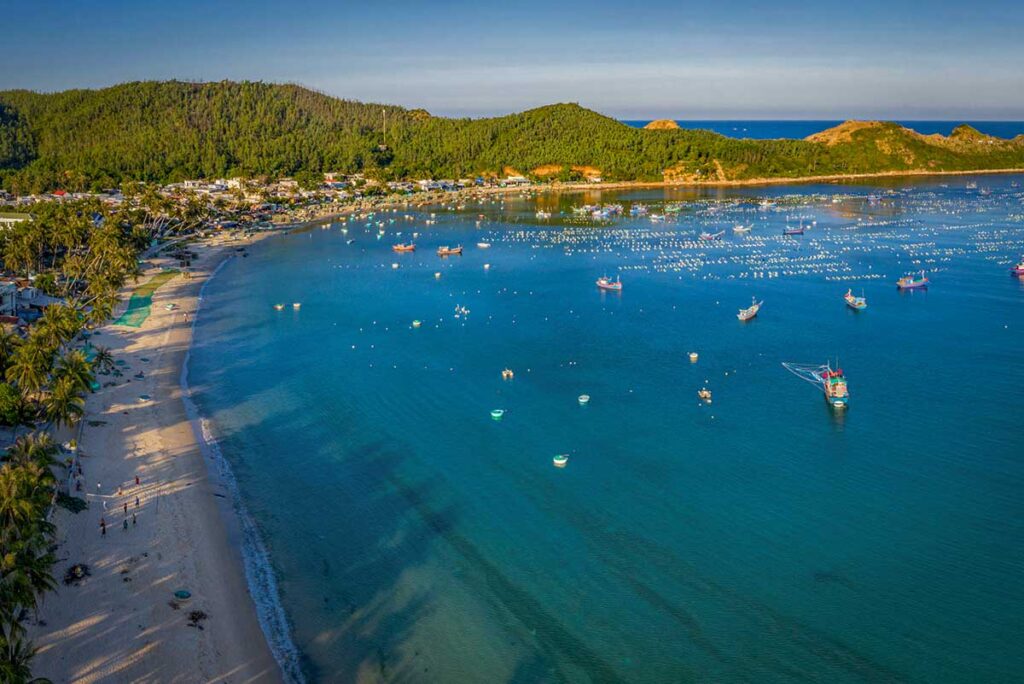
The beach itself is wide and sandy, backed by palms and scattered trees, and the atmosphere is shaped as much by local life as by nature. Development is minimal—just a few small guesthouses and family-run restaurants—so you should not expect resort-style facilities. Instead, the appeal lies in its quiet and rustic character, making it a place for travelers who prefer simple surroundings and an authentic coastal setting over luxury.
What to See and Do at Tu Nham Beach
1. Relaxing & Swimming

Tu Nham Beach is first and foremost a place to relax by the sea. The water is usually clear and calm, with gentle waves that make it safe for swimming. However, like many fishing areas in Vietnam, the tides sometimes wash up plastic and other debris, so conditions can vary. The cleanest stretches are usually those in front of the small guesthouses, where owners make an effort to tidy the sand.
2. Walking the long beach
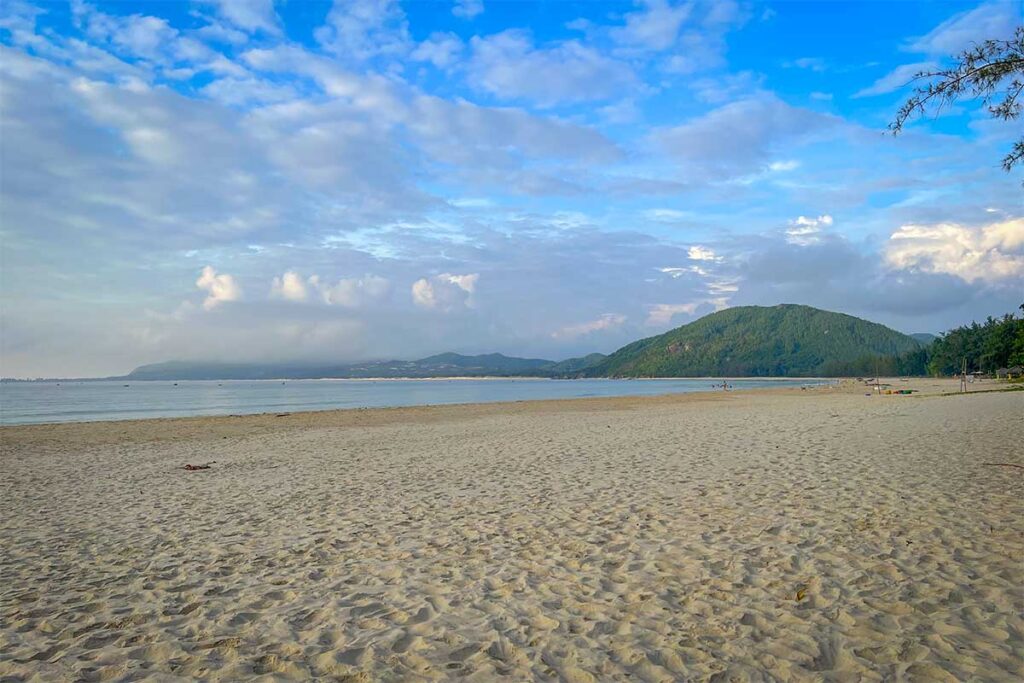
With around 8 kilometers of sand, Tu Nham is ideal for long, quiet walks. The landscape is open and wide, with views of forested hills in the distance and coconut palms scattered along the shore. Since the area is little developed, you can walk for ages without seeing more than a handful of people.
3. Sunrise & Local fishing scene

Early morning is one of the most rewarding times to be here. As the sun comes up, local fishermen push their small wooden boats and round coracles out to sea. It’s a photogenic moment, with the sky shifting colors and the beach slowly coming to life. Watching this daily rhythm of village life is one of the more authentic experiences you can have at Tu Nham.
4. Vinh Hoa Fishing Village

At the northern end of Tu Nham Beach, the small settlement of Vinh Hoa Fishing Village gives the area much of its character. Wooden boats and round coracles line the shore, while fishing nets are spread out to dry under the sun.

Life here goes on largely unaffected by tourism, which adds to the authentic atmosphere. It’s not a tourist attraction in the formal sense—there are no shops or staged performances—so the best way to experience it is simply to walk through quietly, observe respectfully, and take in the daily rhythm of coastal life.
5. Water activities
Some accommodations offer stand-up paddleboards or kayaks for guests, which can be a fun way to enjoy the calm water. Snorkeling is less developed here compared to islands or reefs in Vietnam, and equipment is not commonly available. The bay itself is more suited for casual paddling and swimming than for serious underwater exploration.
6. Dining on the beach
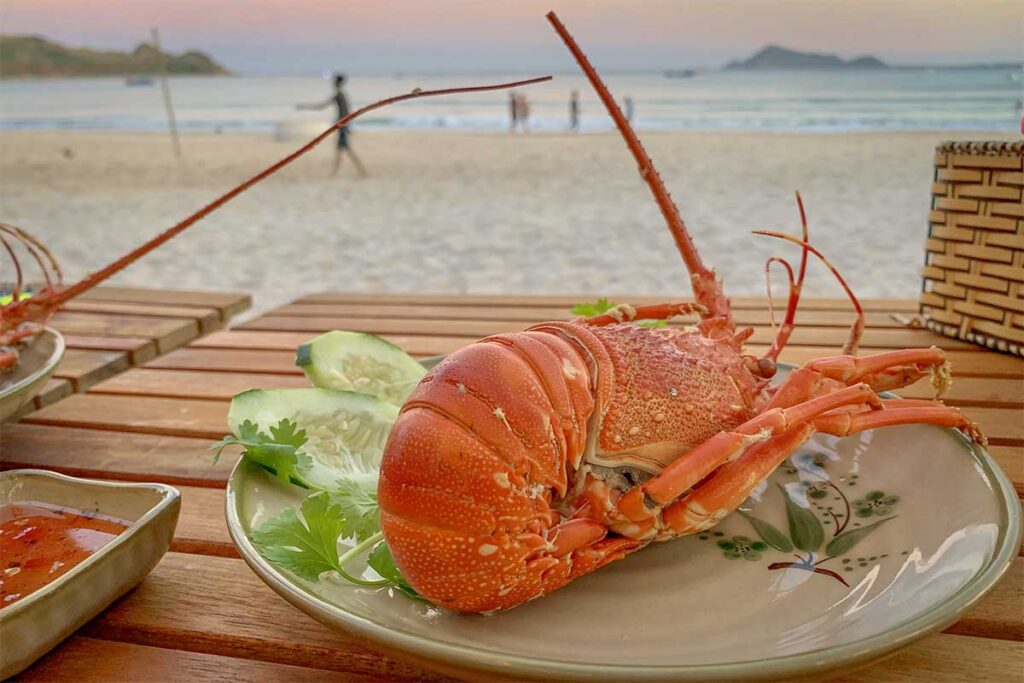
Eating fresh seafood is one of the highlights of staying at Tu Nham. Small restaurants and homestays prepare simple but tasty meals, often based on the daily catch. Some hosts can arrange a lobster or seafood barbecue right on the beach, which is a memorable way to end the day. Since options are limited, most travelers end up dining where they stay, but the quality is generally good and the setting is hard to beat.
Best time to visit
Choosing the right season makes a big difference for a trip to Tu Nham Beach. The weather along this stretch of the coast can shift quickly between calm, sunny beach days and stormy periods with strong winds.
From February to April, conditions are usually the most pleasant—dry skies, warm but not extreme temperatures, and relatively calm seas. This is the best window if you want to enjoy the beach without battling the heat.
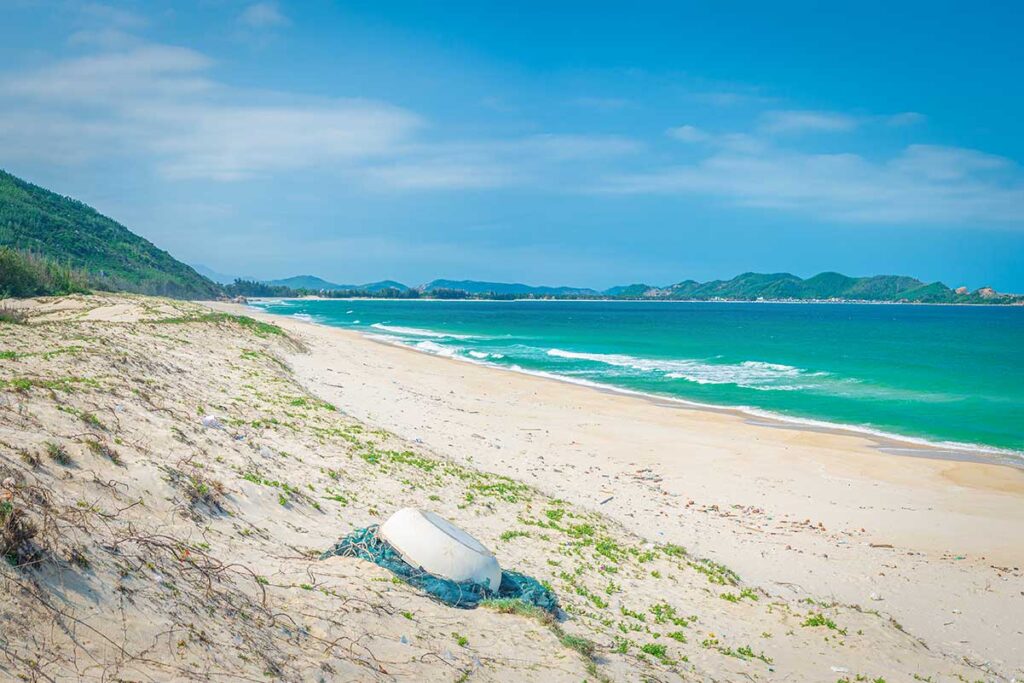
Between March and September, the weather is generally sunny and hot. It’s great for swimming and long beach days, but be prepared for intense midday heat. Bring sun protection and plan your activities for mornings and late afternoons when it’s cooler.
The rainy season, from October to December, is less ideal. Heavy showers and rough seas are common, and strong winds can make swimming unsafe. The beach still has its charm in this season, but it’s not the best time if your main goal is to relax by the water.
Throughout the year, tides and winds can affect swimming conditions. Some days the water is crystal-clear and calm, while on others currents bring in fishing debris. Checking with your accommodation about the daily conditions can help you pick the best time for a swim.
Location & Getting there
Where is Tu Nham Beach?
Tu Nham Beach sits on a peninsula in Song Cau District, Phu Yen Province, roughly halfway between Quy Nhon and Tuy Hoa. The bay stretches for several kilometers, but most visitors know the northern section as Vinh Hoa Beach, where the fishing village and all accommodation are located. It’s a bit out of the way, with small roads leading across the peninsula, which adds to its quiet and undeveloped feel. The nearest larger towns with transport connections are Quy Nhon (about 45 km north) and Tuy Hoa (about 55 km south).
Taxi or Ride-Hailing
Taxis from Quy Nhon or Tuy Hoa can take you directly to Tu Nham Beach, but it’s a long ride by local standards and return trips aren’t always easy to arrange. Grab and other ride-hailing apps work in the bigger towns, but coverage on the peninsula is very limited. If you take a taxi, it’s best to agree on a round trip or ask the driver to wait for you while you visit.
Car with driver
Hiring a private car with driver is the most convenient way to reach Tu Nham, especially if you want to combine it with nearby stops like Vinh Hoa or Bai Om Beach. Prices are agreed in advance, and the driver will wait for you at each stop, making it a stress-free option for families or groups. This is also the best choice if you want to explore several coastal spots in a single day without worrying about transport back.
Renting a motorbike
For independent travelers, renting a motorbike is a cheap and flexible option. The roads to the peninsula are a mix of paved sections and rougher dirt tracks, but traffic is light compared to big cities. It’s more adventurous than a car, but manageable for most riders with some experience. Officially you need a valid motorbike license and an International Driving Permit, even though local shops often don’t check. Riding also gives you the freedom to explore the fishing villages and hidden coves around Tu Nham at your own pace.
Staying at Tu Nham Beach
Accommodation at Tu Nham Beach is small-scale and simple, which fits the quiet, local character of the area. You won’t find resorts or large hotels here—just a few guesthouses and bungalows run by local families or expat owners.
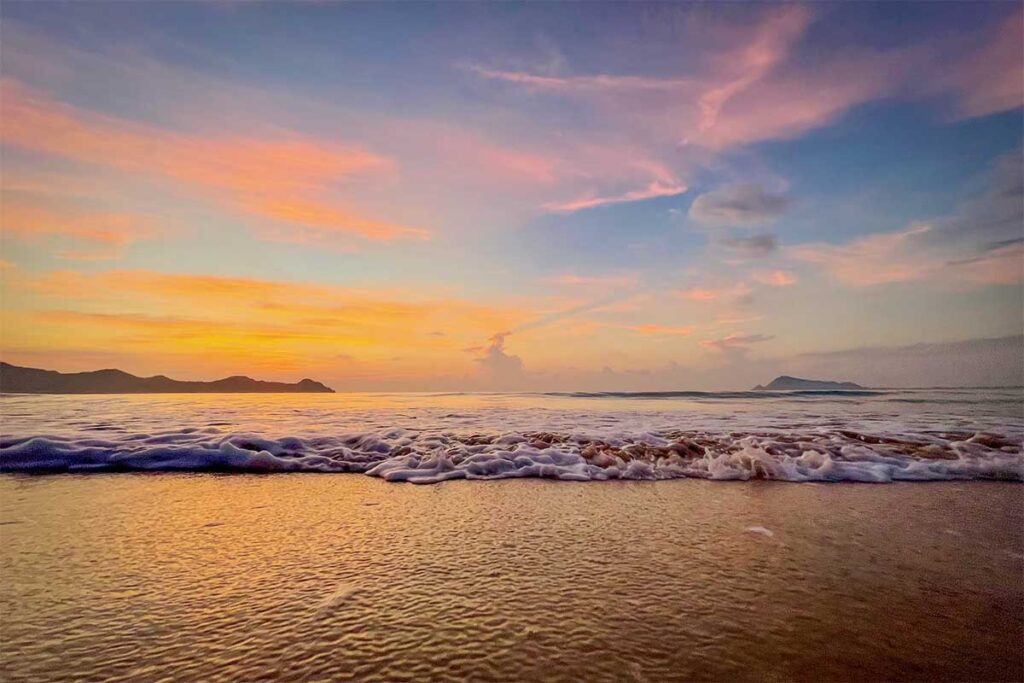
In practice, all accommodation is located at the northern end of the bay, known as Vinh Hoa Beach, where the fishing village is based. Staying overnight here is the best way to enjoy the coast, as dining options are limited and the atmosphere is most rewarding in the mornings and evenings.
Lucky Spot Bungalow
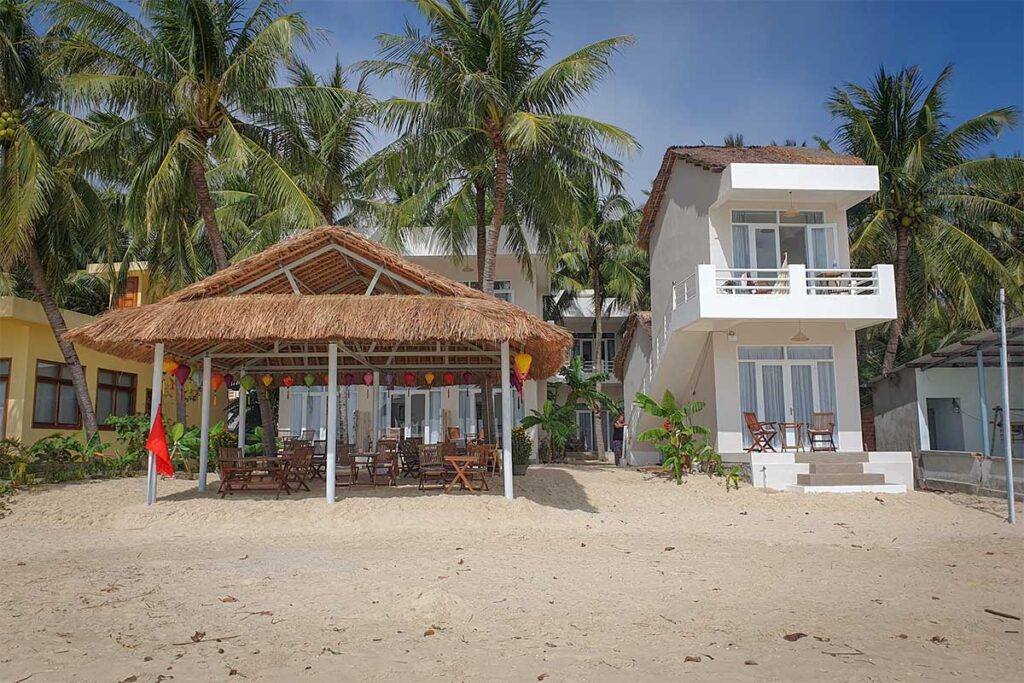
Lucky Spot is one of the more comfortable choices, set directly on the sand with ocean-facing rooms. Guests often highlight the warm, helpful staff and the authentic location in a small fishing village. The beach right in front is usually kept clean, and the guesthouse makes an effort to support the local community. Downsides include occasional karaoke noise from the village in the evenings and the fact that some stretches of beach further away can be affected by fishing debris.
Timothe Beach Apartments

Timothe Beach Apartments are in a scenic position with wide sea views and a rustic, laid-back feel. Meals are a highlight here, with the possibility of arranging a lobster or seafood BBQ on the beach. However, reviews are mixed: while some travelers find it a hidden paradise, others mention maintenance issues such as broken fixtures or less-than-perfect cleaning. It’s a good choice if you value location and food over polished facilities.
Robinson Beach Bungalow

Robinson Beach Bungalow is a basic but charming family-run option directly by the sea. Rooms are simple and facilities rustic, but the atmosphere is friendly and relaxed. It’s good value for money and suits travelers who don’t mind a few inconveniences, such as mosquitoes or occasional fishy smells from the nearby farms.
General advice: Most visitors end up dining at their accommodation, as independent restaurants are limited. Local homestays and bungalows usually serve fresh seafood and Vietnamese home-style meals. If you expect variety, it’s best to bring some snacks or plan to eat with your hosts.
Practical tips for visiting Tu Nham Beach
- Bring cash – There are no ATMs on the peninsula and most small guesthouses and restaurants only accept cash.
- Expect basic facilities – Don’t count on shops, convenience stores, or tourist services; it’s a simple beach setting.
- Carry mosquito repellent – Insects can be an issue, especially in the evenings or in rooms without nets.
- Check tide and weather before swimming – Conditions can change quickly, with calm water on some days and rougher currents on others.
- Beach cleanliness varies – Debris from fishing sometimes washes ashore. Hotels and bungalows often clean the sections in front of their property, which are the best places to swim.
- Road access is mixed – Expect a combination of paved lanes and rougher dirt tracks. Drive carefully, especially if visiting by motorbike.
- Karaoke is common in villages – Local families enjoy karaoke in the evenings, so don’t be surprised by music carrying across the beach at night.
Is Tu Nham Beach worth visiting?
Tu Nham Beach is, in many ways, one of the most beautiful beaches in Vietnam. Its long sandy bay, framed by palms and a fishing village backdrop, offers a raw and authentic coastal atmosphere that is hard to find elsewhere. The setting feels untouched compared to more famous beach destinations, making it a special place for those who enjoy quiet and natural surroundings.
That said, it is still a remote spot with both charm and imperfections. Facilities are simple, dining options are limited, and you may encounter fishing debris on parts of the beach. If you are after nightlife, luxury resorts, or completely spotless sands, Tu Nham may not fit your expectations. But for travelers seeking a truly scenic and off-the-beaten-path escape, it is an exceptional choice.
